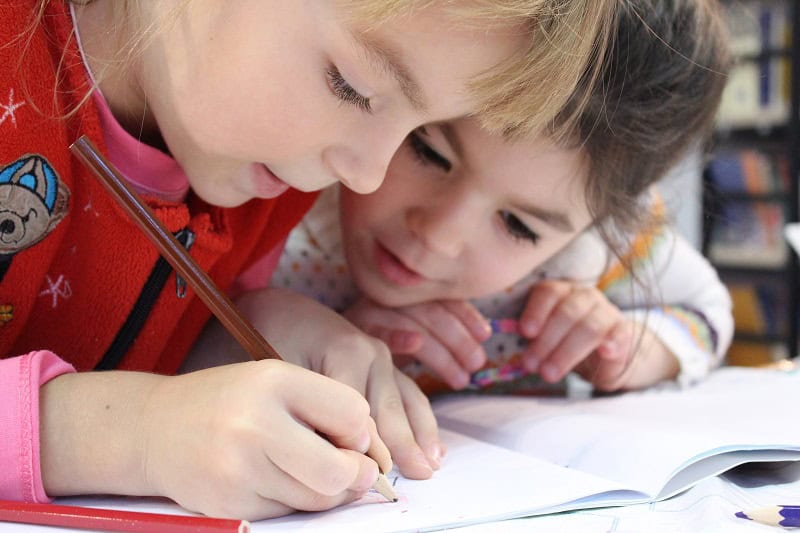Tears and worries. Overwhelm and concern.
These six words characterized some of our family’s first homeschooling days over a decade ago.
They’ve also characterized the past week for many around the globe as we track the news on the coronavirus COVID-19–with the astounding result that millions now find themselves home with their children for at least a couple of weeks.
While I believe that you and your kids would be fine if you took these days “off” from school, I know that in uncertain times, routine can be a comfort.
So whether you end up homeschooling for a week, a month, or a semester–here’s what I would love for you to know to make your journey easier:
1. You are not going to screw up your child’s education.
Thousands of families have gone before you worldwide to home educate their children, and many of the top universities seek out homeschool graduates because of the positive results they’ve become known for.
You can totally do this, yet it’s important to keep in mind that:
2. Schooling at home does not work the same way as in a classroom.
There’s a big difference between 20 children at school and one to three (or more) at home. Yet one of the biggest mistakes new homeschoolers often make is to try to copy the system they’re familiar with.
It usually works better to depend more on the strength and informality of the home environment.
If you focus on putting relationships first, instead of assignments, (especially in this time of crisis), you’ll find that everything flows easier.
3. Homeschooling doesn’t take as long as traditional schooling.
Much of the time in a classroom is spent not on direct instruction and learning, but on the logistics of managing so many children at once. Some teachers estimate that the actual learning time in a typical school day is around 2.5 hours.
Other studies on brain chemistry, the lives of great influencers, as well as more recent studies of the productivity of office workers point to this 2-4 hour time period as well.
This rings true based on what I’ve seen in our homeschool and heard from thousands of homeschooling parents over the past decade. And it’s good news for those of you who must juggle your own work schedule during the coronavirus.
So based on all of the above, I propose this technique:
The 3 Hour Homeschool Solution
(Note: This is also a great plan for new homeschoolers or those who need a reset in their homeschool at anytime!)
Here’s how it works:
1. Pick any 3 hour block of time that works for your family.
It could be 9am-noon. Or if you have late-sleeping teens, 11am-2pm. If you need to split the hours up throughout the day, doing one here and another there, that could work too.
It might be best if this time range is the same each day, but if that’s not possible, it’s fine too.
2. Define what is and isn’t allowed during this time.
Your goal is that these three hours will be dedicated to learning in some way on the days you decide are “school days.”
Approved activities for homeschool hours in our home include educational apps and websites (but NOT screens for entertainment, texting, or social media), reading and audiobooks, traditional lessons and workbooks, and artistic pursuits like drawing.
When my kids were younger homeschool hours could also include creative activities like baking or cooking, imaginative toys like Lego and blocks, and a recess outside to get the wiggles out.
Once you decide what is and isn’t allowed, have a family meeting where you explain it to your kids in an age-appropriate way, so everyone has clearly defined expectations.
3. Each hour has a slightly different objective:
Hour 1 – Any essential academics (language arts/math/etc)
Hour 2 – Books in all forms: Read-alouds, individual reading, audiobooks
Hour 3 – Games, Documentaries, Podcasts, Online learning
Important Note: You can switch these hours around in any order based on what will work best for you!
Also, I don’t mean to suggest that each activity has to FILL the entire hour.
Young kids may need less than 30 minutes of essential academics; teens may need slightly more than 1 hour, so adjust as needed!
It’s actually ideal if the hours spill into each other, without an alarm to separate them. So if a child gets interested in a good book or a board game championship evolves, go with it!
That’s the gold of the homeschool lifestyle–its flexibility.
Also, you do not have to directly “teach” this entire time–just try to be as available as you can given your other responsibilities and work. And if you don’t want your kids using screens frivolously, model that for them by staying away from constant news feeds and other distractions!
With that said, let’s take a deeper look at what each hour could include:
Hour 1: Any Essential Academics
For ages 5-12
If your kids were sent home with work to do, on paper or online, that represents your essentials.
But if you feel like you weren’t given enough guidance, order a Brain Quest workbook (afflink) (or something similar) for your child’s current level (PreK-Grade 6).
Based on their age, have them do one (or more) language arts pages, and one (or more) math pages each homeschool day.
If you’re not able to help a child directly due to your own work schedule, do what you can and lean on technology for the rest: You can sign up for a 4 week free trial to Reading Eggs and Mathseeds (for ages 2-13) here, which could be a lifesaver!
For ages 13 and up:
If your child is in middle or high school, they have already learned the basics. This means that even a month away from school is not going to ruin their future–take the long-view and relax!
With that said, adapt the concept above of incremental progress for your teens, having them focusing on the most important skill areas of math and any language arts essentials.
NOTE: After everyone’s essentials are done for the day (or after your entire 3 hours are done), celebrate with hot chocolate, a cookie, the bean jar, or some other reward. We call this “Skills Learning Treats” in our home.
Do not turn these studies into a dreaded chore (if it becomes one, make a change). And do not worry about this “reward” spoiling them.
It’s more likely to be something your kids remember fondly about this time.
Hour 2: Books in all forms: Read-alouds, individual reading, audiobooks
Reading aloud and learning through books is one of the central methods of instruction that homeschoolers depend on. It’s the simplest way to integrate a variety of subjects at once!
Head to your own book shelves at home if your library is currently closed to reread favorites and make time for those titles that you’ve always wanted to get around to.
If you do have access to a library, my book Give Your Child the World: Raising Globally-Minded Kids One Book at a Time will help you cover both geography and history as you simply read aloud!
Also check out these lists of top read-alouds for ages 5-12 and these historical books for teens to get you started.
Audiobooks can be excellent during this time as well, letting you read a book while you drive or while your student draws or builds Lego!
Hour 3: Games, Documentaries, Podcasts, and/or Online Learning
Take your pick of what interests your family below:
Games: Find my favorite math board games here, check out the very timely Election Night! game, or choose among those that might already be dusty in your closets!
Videos: PBS Kids, Crash Course for kids or Crash Course for teens, CNN10 for teens, and/or make a list from the documentary section of Amazon and Netflix.
Podcasts: My friend Cait has an excellent list of favorites here!
Online Learning: Other Goose is offering 3 weeks free for ages 2-7, Scholastic has put together some excellent free unit studies here, and don’t forget Khan Academy!
Imagine your family ten years from now, looking back on this time. What will you want to remember most? How does this sound:
Read-alouds on the sofa under cozy blankets, baking and cooking, dealing with squabbles and bad attitudes (this is real life, after all), chores, Lego villages, discussions around the table, documentaries and movies, time spent outdoors, board games, ice cream and audiobooks, online learning and podcasts.
In other words, HOME.
In the midst of so much uncertainty, let’s do our best to enjoy this unexpected gift of time with our children. I hope this helps guide your way just a little!

